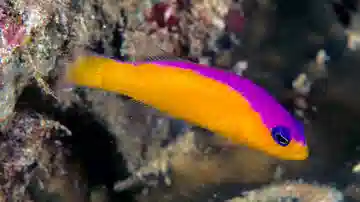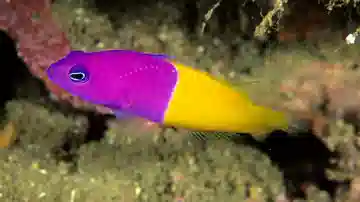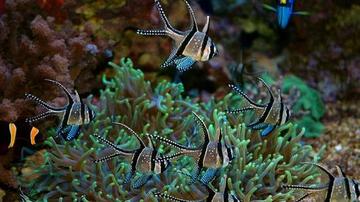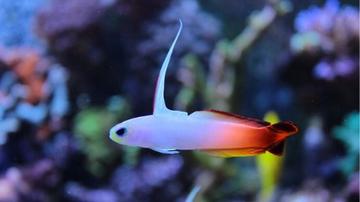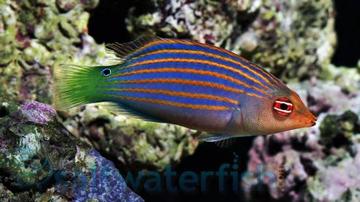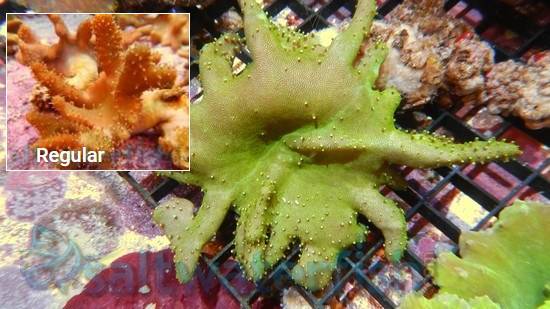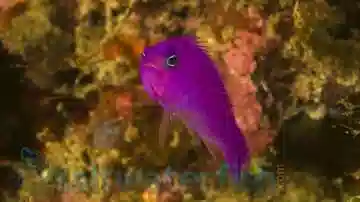Purple Pseudochromis
Pictichromis porphyreus
(42 Reviews)
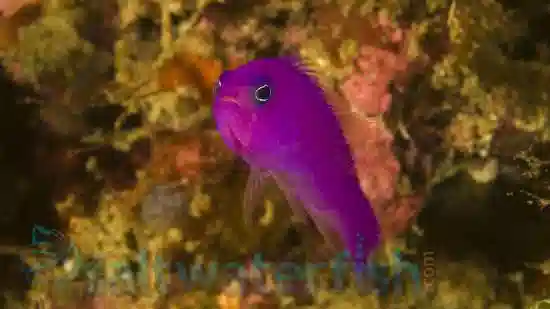
Purple Pseudochromis
Pictichromis porphyreus
(42 Reviews)
{{ item.name }}
Size: {{ item.extra_field_3 }}
${{ getFormattedPrice(item.saleprice) }} ${{ getFormattedPrice(item.price) }}
To join the waiting list, click here
Free Shipping
With
$199.00
or more in Marine Life.
More details...
Purple Pseudochromis Care Facts
| Care Level: | Easy |
|---|---|
| Temperament: | Semi-Aggressive |
| Diet: | Canivore |
| Reef Safe: | Yes |
| Minimum Tank Size: | 30 gallons |
| Max Size: | 3 inches |
Keeping the Purple Pseudochromis (Pictichromis porphyreus) in Your Saltwater Aquarium
The Purple Pseudochromis, scientifically known as Pictichromis porphyreus, is a fascinating and colorful addition to saltwater aquariums. In this comprehensive guide, we will provide essential information on successfully caring for Purple Pseudochromis, including insights into their habitat, reef compatibility, size, lifespan, dietary needs in captivity, availability through aquaculture, compatibility with other marine species, sexual dimorphism, changes in coloration from juvenile to adult stages, temperament, specific tank requirements, and precise water conditions. We will also list common names for this species and explain why acquiring Purple Pseudochromis from Saltwaterfish.com is a wise choice.
Habitat and Natural Range of the Purple Pseudochromis
Purple Pseudochromis are native to the Western Pacific Ocean and commonly found in Fiji and Tonga waters. They inhabit rocky reefs and coral outcrops, seeking shelter in crevices and small caves. In your aquarium, it's essential to replicate this natural habitat by providing ample hiding places among live rock and coral formations.
Reef Compatibility of the Purple Pseudochromis
Purple Pseudochromis are generally considered reef-safe, making them suitable for reef aquariums. They typically do not harm corals or invertebrates. However, like many saltwater fish, their compatibility largely depends on individual temperament and the specific combination of species in your tank. Always monitor their behavior when introducing them to a reef environment.
Size and Lifespan of the Purple Pseudochromis
Purple Pseudochromis typically grows to a modest size, reaching an average length of 3 to 4 inches (7.62 to 10.16 centimeters). In a well-maintained aquarium, they can live for several years, up to 5 to 7 years.
The Diet for the Purple Pseudochromis
Purple Pseudochromis feed on small crustaceans, zooplankton, and tiny invertebrates in their natural habitat. To ensure their health and vibrancy in captivity, provide a balanced diet consisting of the following:
- High-Quality Marine Pellets and Flakes: These should be a staple in their diet, as they offer essential nutrients and can be easily consumed.
- Live and Frozen Foods: Supplement their diet with live or frozen offerings such as brine shrimp, mysis shrimp, and finely chopped seafood. This variety mimics their natural feeding habits and provides essential nutrients.
- Occasional Small Live Prey: Purple Pseudochromis may occasionally accept small live prey, such as copepods and amphipods.
Aquaculture and Availability of the Purple Pseudochromis
Aquacultured specimens of Purple Pseudochromis are occasionally available to hobbyists. Acquiring aquacultured individuals can benefit both the fish and the environment, as it reduces pressure on wild populations and often results in hardier, disease-resistant specimens. If aquacultured specimens are unavailable or suitable for your requirements, choose responsibly collected wild-caught specimens.
Compatibility of the Purple Pseudochromis with Other Fish and Invertebrates
The Purple Pseudochromis is generally peaceful, making it compatible with other marine species. When selecting tank mates, consider the following factors:
- Compatible Tank Mates: Opt for species that are not aggressive or overly territorial, as Purple Pseudochromis prefer a tranquil environment.
- Size Considerations: Be cautious about pairing them with significantly larger or aggressive fish that may intimidate or harm them.
- Invertebrates: Purple Pseudochromis are typically safe around corals and invertebrates, but individual behavior can vary.
Sexual Dimorphism of the Purple Pseudochromis
Purple Pseudochromis do not exhibit strong sexual dimorphism, which means that males and females share similar physical characteristics. Distinguishing between the sexes based on appearance is challenging.
Juvenile to Adult Coloration Changes of the Purple Pseudochromis
Juvenile Purple Pseudochromis often have a lighter, pinkish-purple body with a contrasting bright yellow tail. Their coloration intensifies as they mature into adulthood, with a deep, rich purple or violet body. This striking transformation adds visual appeal to your aquarium.
Temperament of the Purple Pseudochromis
Purple Pseudochromis are known for their curious and inquisitive nature. They are active swimmers and enjoy exploring the nooks and crannies of your aquarium. While they are generally peaceful, some individual variation in temperament can occur. Observing their behavior and monitoring their interactions with tank mates is essential to ensure compatibility.
Tank Requirements
To create an ideal environment for Purple Pseudochromis, consider the following tank requirements:
- Minimum Aquarium Size: A minimum tank size of 30 gallons is recommended to provide sufficient space for them to swim and establish their territory.
- Aquascape: Provide plenty of live rock structures, caves, and hiding spots for these fish to seek refuge and establish territories.
- Tank Lid: Ensure your aquarium has a secure lid to prevent accidental jumps. Purple Pseudochromis are known to be occasional jumpers.
Water Conditions
Precise water conditions are essential for the well-being of your Purple Pseudochromis:
- pH Level: Maintain a stable pH level within the range of 8.1 to 8.4.
- Salinity: Keep salinity levels consistent at approximately 1.025 for optimal health.
- Water Temperature: Maintain a water temperature range of 74°F to 80°F (23°C to 27°C).
- Water Flow: Purple Pseudochromis prefer moderate water flow within the aquarium.
Common Names of the Purple Pseudochromis
The Purple Pseudochromis is known by common names such as Orchid Dottyback, Orchid Dottyback, and Magenta Dottyback.
Why Choose Purple Pseudochromis from Saltwaterfish.com?
Acquiring Purple Pseudochromis from Saltwaterfish.com offers several advantages:
- Healthy Specimens: Saltwaterfish.com is dedicated to providing customers with vibrant, well-acclimated Purple Pseudochromis, ensuring their readiness for aquarium life and contributing to their long-term well-being.
- Responsible Sourcing: By acquiring these fish from Saltwaterfish.com, you support responsible sourcing and ethical collection practices for marine species.
- Expert Guidance: Saltwaterfish.com offers expert guidance and support to help you provide the best care for your Purple Pseudochromis in your saltwater aquarium.
In conclusion, the Purple Pseudochromis (Pseudochromis porphyreus) is an attractive, peaceful fish that can be an excellent addition to your saltwater aquarium. Renowned for its mesmerizing coloration and inquisitive nature, these dottybacks are an excellent choice for marine enthusiasts. Choosing Purple Pseudochromis from Saltwaterfish.com ensures access to healthy specimens and expert advice for their successful care in your aquarium.
Very nice
Reviewed by: Bobbi Link on Dec. 15, 2024
Bright, very colorful.
Reviewed by: Shaun Huddleston on Oct. 23, 2024
Reviewed by: Paige Hutchinson on Oct. 20, 2024
Good fish.
Reviewed by: Tuan Tran on Oct. 18, 2024
Beautiful
Reviewed by: Scott Olson on Oct. 9, 2024
Love it
Reviewed by: Scott Olson on Sept. 29, 2024
Reviewed by: Gary Sparks on Sept. 11, 2024
Reviewed by: Gary Sparks on Sept. 9, 2024
Great color and very healthy
Reviewed by: Anthony Balatti on Sept. 1, 2024
Adds great color to the reef, nice specimen.
Reviewed by: Timothy Thomas on Aug. 28, 2024
Bright colored
Reviewed by: Shaun Huddleston on July 18, 2024
Great purple color
Reviewed by: Jim Hauck on July 8, 2024
Reviewed by: Jana Hess on July 6, 2024
Reviewed by: Jana Hess on June 24, 2024
Very shy but throw food in the tank and. Join right away
Reviewed by: Alvin Barbes on June 17, 2024
Reviewed by: Billy Springer on May 13, 2024
Everything was great will order again soon
Reviewed by: Alan Amtmann on April 30, 2024
Reviewed by: Debra K Mabrey on April 3, 2024
Really fast shipping was very happy with the fish looking to buy a lot more
Reviewed by: Richard Staats on Jan. 29, 2024
Beautiful color
Reviewed by: Mike Perdue on Jan. 17, 2024
Reviewed by: Jason Salyer on Jan. 16, 2024
Great
Reviewed by: Edward A Wilburn on Jan. 12, 2024
Absolutely love this fish! Brings so much color to the tank and is actually very well behaved and gets along with all my fish, even the ones you would think he would be territorial with. A great addition to your tank if you already don't have one.
Reviewed by: Dale Pichelmayer on Jan. 10, 2024
Reviewed by: Laurence Somers on Dec. 25, 2023
Found homes right away.
Reviewed by: Jerry Albright on Dec. 18, 2023
Vibrant and active
Reviewed by: James Miller on Dec. 11, 2023
Reviewed by: Debbie Konechney on Dec. 11, 2023
Reviewed by: Hayden Hendricks on Nov. 26, 2023
What a beautiful magenta color. They're more active each day
Reviewed by: Eric Wilson on Oct. 29, 2023
Reviewed by: Brad Fritza on Oct. 28, 2023
Reviewed by: Eric Wilson on Oct. 24, 2023
Reviewed by: Laurence Somers on Oct. 14, 2023
This guy is doing great in quarantine after less than a week and i hope he does well in my DT
Reviewed by: Jim Minor on Sept. 24, 2023
Color is beautiful. Love the different color in my tank
Reviewed by: Kim Smith on Sept. 13, 2023
Reviewed by: Woody Johnson on Sept. 6, 2023
Reviewed by: Richard Walker on Aug. 8, 2023
Beautiful fish, active and eating within a few days.
Reviewed by: Laurence Somers on Aug. 4, 2023
Reviewed by: Susan Alexandre on July 24, 2023
Reviewed by: John Cordova on June 28, 2023
Had mine for 2 years and it was good with all other fish and invertebrates. I did have a very small hole in my lid for my filtration, and it found it. Was looking for it for a few days till I found it behind the tank on the floor. Beautiful fish. Make sure on your lid.
Reviewed by: John Atella on June 7, 2022
I received this about 10 days ago. The little guy hits in the rocks but swims out for a bit. It is settling in nicely and the color is a deep purple. A very pretty addition!
Reviewed by: Eric Roberts on Aug. 22, 2016
An absolutely gorgeous fish! He quickly made friends with my other fish, and his color looks so pretty in my tank.
Reviewed by: Lisa on July 3, 2015


